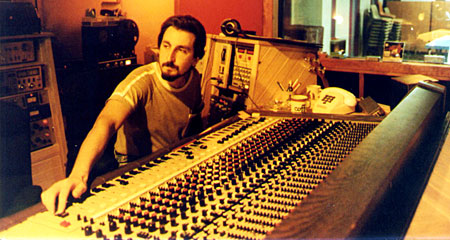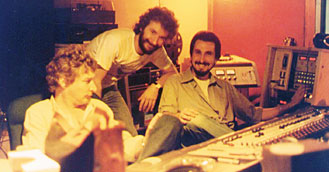

MCI's famous 400 series consoles were the first to introduce the "inline" configuration to recording consoles around the mid 70's. The first one of these consoles went to Atlantic Studios and many classic recordings which we know and love today were produced on this console.
When MCI introduced the world's first automated JH-500 console in the late 70's, they also gave the 400 Series a makeover, introducing the JH-400B with the same ARMS automation system.
The JH-400 series are quad desks in various sizes, with 4 sends. The original consoles had 16 busses. The JH-400B only had 16 assign buttons, so the motherboard was configured so that lower channel numbers assign to 1-16 only, whilst higher channels assign to 9-24 only.
The Sun JH-400B was fitted with an automation system and colourful incandascent lamp lit light meters with a spectrum analyser function.
Unlike most current console designs, the fader comes before the EQ stage. Whilst this configuration makes the channel virtually overload-proof, it is difficult to insert a compressor post EQ. On the JH-400 series, the channel insert point is pre-fader and EQ only.
All stages are transistor buffered MCI 2001 ICs, which run off ±24V rails, allowing ample headroom throughout. The replacement is the MCI 2002, which is very hard to obtain these days. The good news is that they rarely seem to fail. The overall signal path is very simple, with a minimal number of audio stages. All audio routing is done with relays and switches. This results in a very clean signal path, with only a few transformers thrown in. However, relays from this era have proven to be less reliable than FET switching. There are two types of relays in this desk. Firstly, an Electrosil reed relay which although had very high quality contacts, became infamous for open circuit coils. There is no point in buying new equivalents even if you can get them, since they will almost certainly fail too. The other type is a Siemens 4-pole changeover type - unsealed. You can keep these going with careful maintenance but they were generally troublesome. There were relay upgrade kits using a different gas sealed type available from MCI/Sony at one time. It is possible that many JH-400's today would have the retro-fitted relays and if buying one it is worth checking for this.
Line inputs and outputs are transformer balanced. The 3 band EQ is fixed Q but uses precision switching instead of potentiometers. The mic preamps incorporate Jensen transformers and are similar in design to the API, Quad-Eight and Auditronics consoles. The JH-400 version runs off higher voltage than normal, which increases the headroom of the mic preamp output. On top of this, the nominal mic preamp output level at the patch bay is -6dBm, increasing the preamp headroom to 30dB! Ideally, an old-school compressor/limiter with a line level control directly on the input such as an 1176 is inserted at this point and this results in a superior peak handling ability for microphone signals to what could be achieved with most modern console mic preamps.
Although many engineers were impressed by the performance of the 400 series, they fell out of favour by the mid 80's due to their limited number of sends and signal routing versatility which failed to satisfy the demands of the racks of outboard gear and synth modules of the day. Ironically, they would now be ideal for a modern medium size digital studio, as a high quality analogue front end and monitoring system.
The MCI JH-400B console from Sun Studios, which once accounted for a major slice of the music recorded in Sydney for the advertising industry, lives on!
I completed a major restoration job on this console, which has changed homes several times since Sun.
Most of the modules were still in surprisingly good condition, with an apparently low failure rate of the proprietary MCI 2001 ICs.
Unfortunately, there were also extensive problems and damage due to incompetent workmanship which had to be rectified. The automation system was severely blown up. In addition to having to replace a large number of obviously blown chips (most of them having to be obtained overseas), there were several really nasty faults which took a long time to sort out. On top of that, it was necessary to "unmodify" all 24 VCA Fader modules. Finally, we had a clean, stable desk!
